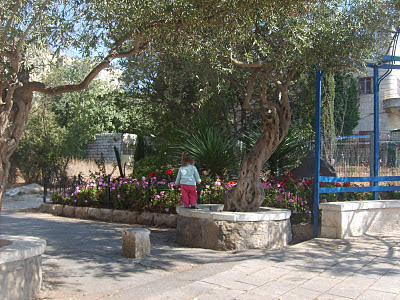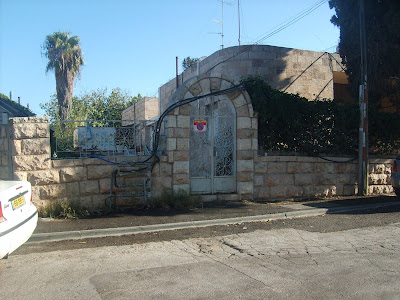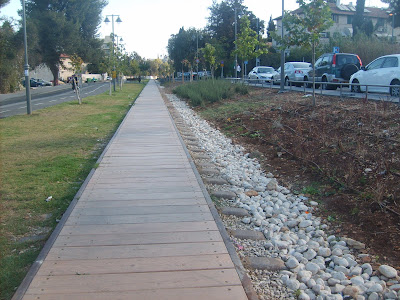For about four years now I've been cringing at sights like the following:
It's true that after a while you can get used to things that once drove you nuts. I guess some of the shock value of these Jerusalem Municipality advertising installations has worn off by now; but I still think they are ugly, strident, vulgar, and altogether inconsistent with the subtlety and refinement that I associate with Jerusalem. I also think that they have, for the most part, been inappropriately placed. Moreover, they are not very effective at their appointed task -- delivering commercial and cultural information -- for reasons that I will set forth later in this post.
I used to have a theory about how these ad installations got authorized to begin with. The fact that they first appeared under the mayoral administration of ultra-Orthodox Uri Lupoliansky made me think it was an encroachment of the pashkevil aesthetic into parts of Jerusalem where that aesthetic didn't belong. Now, Lupoliansky did get a lot of flak from the ultra-Orthodox community for trying to clear the streets of unauthorized posters in haredi strongholds like Mea Shearim -- but it was also during his term as mayor that these formal ad installations began to appear throughout Jerusalem, including in the non-haredi parts of town. The two phenomena -- the Mea Shearim cleanup and the citywide oudoor advertising free-for-all -- were apparently two sides of the same coin, the latter being an "authorized" communication channel that supposedly kept the former in check.
Whether the introduction of municipal ad installations had the desired effect of keeping unauthorized posters off the walls of Mea Shearim, I don't really know -- but I tend to doubt it. Whatever the outcome on that side of town, I had never noticed a problem with bandit billboards on, for instance, Emek Refaim St. (in the lively and heterogeneous German Colony), and so I consider the placement of ad installations there to constitute an introduction of visual pollution where there had been none before:
 |
| Stately entrance to old Templer cemetery, Emek Refaim St. -- an appropriate site for commercial advertising? |
Well, I still want them gone; but in the meantime my attitude toward outdoor publicity/advertising has gained a bit of nuance. I've come to recognize that different cities, and different parts of the same city, can take different approaches to advertising. At one end of the spectrum, New York's Times Square can hardly be imagined without its giant billboards. By contrast, Los Angeles has banned digital billboards and multistorey signs. And at the opposite end of the spectrum, Sao Paulo, Brazil, via its Clean City Law, has rid itself altogether of billboards, posters and bus ads.
And then there's Paris with its Morris columns:
 |
| Jeune femme traversant le boulevard -- Jean Béraud (via Wikimedia Commons) |
A more up-to-date version:
 |
| via Wikipedia |
It's also worth noting that the Morris columns of Paris, with their "crown" detail, etc., are designed with an obvious concern for aesthetics. Not only that, but the very concept of a three-dimensional pillar display, rather than a flat "screen-like" expanse, has something distinctly human, tactile and fun about it. This was brought home to me recently as I took a good look at an object that had been lying around my house since my oldest son was a toddler -- a cardboard stand-up street scene that could serve as a child's primer on the New Urbanism:
The street scene (apparently a European import) features an advertising pillar (far left), and you can see how, under the right conditions, outdoor advertising might contribute just the right degree of liveliness to a street environment, without being overwhelming or vulgar. In this image, if you look closely, you can make out two children playing peek-a-boo around the column. Now picture a real-life street scene, in which well-dressed Parisians glide around a cylinder of this kind in an elegant pas-de-deux as they scan it for news. It almost looks like a form of two-way communication.
Although I spent time in Paris as a student many moons ago, I somehow never thought to connect those Morris columns with the Jerusalem ad installations that have sprouted like poisonous mushrooms around the city over the last four years. They are so different visually that I simply couldn't place them in the same universe, although technically they both fall into the categories of street furniture and outdoor advertising media.
The pashkevil connection aside, what I find so objectionable about the Jerusalem ad installations is the sheer lack of humanity evident both in their design and in their deployment.
The Parisian pillars are not intended for view by drivers, but by pedestrians (their invention pre-dates the auto, after all). Even when they are placed at intersections (as in one of the above photos), they clearly are meant to catch the eye of the human being crossing the street, not the driver waiting for the light. And (at least based on a scan of images -- and there are lots of them -- via Google) they are by no means placed exclusively at intersections.
By contrast, the Jerusalem installations are pretty consistently situated at intersections, including many that get very little foot traffic:
| Hebron Rd.-Shmuel Meir Blvd. |
(Given this inefficacy, it's really too bad that the lovely pastoral view of an olive grove had to be sacrificed to the municipal advertising imperative.)
My favorite, of course, is when the ad installations are positioned near traffic circles. Apparently, drivers are expected to crane their necks to make out what's written on the posters while they're driving around the circles:
 |
| Traffic circle at entrance to Har Homa. You can't make out anything on those ad boards while you're whizzing past ... |
Yet I would argue that even when the installations are placed in spots with heavy pedestrian traffic, they are not particularly effective. It's true that on a busy street like Emek Refaim, people will definitely stop to look at them. But you have to step back awkwardly in order to focus on the text of the posters ...
... risking collision with other people at a teeming intersection, and then shield your eyes from the psychadelic glare. The installations, jam-packed with posters superimposed each on the other, in eye-blistering colors that clash both with each other and with the otherwise stately and graceful Jerusalem landscape, are simply not scaled for the human eye at street level.
What is more, they take up an awful lot of visual "space." Unlike Morris columns, which attract attention but do not overwhelm, the Jerusalem ad installations are a form of visual hijacking. Look at how the view of a lovely Old Katamon house and its garden is obstructed by -- not one, but two -- installations:
Here an ad board disrupts the tranquillity of a residential Baka street:
The above intersection, Efraim and Gideon streets, is just a couple of blocks away from both Emek Refaim and Derech Beit Lechem -- two major commercial hubs that have certainly received their share of ad installations. Couldn't the Municipality have let this quiet little street slumber in peace? Or do they think the Day-glo colors contrast elegantly with Jerusalem stone?
And, what about the local residents who have to look out their windows at the backs of these things, or the pedestrians who have to accept these grey and lifeless metal backsides as part of the streetscape:
It's nice to know that Ariel, the Jerusalem muncipal company that is responsible for these eyesores, takes pride in the installations' aesthetic caliber.
On its website Ariel doesn't bother to name either the company to which it has contracted the twice-weekly changing of the posters, or the "sponsor" that it "recruited" several years ago to "replace 300 old and broken-down installations around the city, at a cost of millions of shekels, in exchange for advertising rights to the upper portion of the installations." [emphases mine -- Julie@walkablejlm]
The term "recruited" struck me as intriguingly vague. Isn't this the kind of service that a municipality would normally publish a tender for?
I did some digging, and came up with the following:
In 2008 the Jerusalem Municipality did issue a tender for the provision of outdoor advertising/street furniture services -- after a lengthy period in which such services had been provided by multiple companies on a short-term contract basis. Jerusalem was, at that time, following the lead of Tel Aviv, which had recently entered into an agreement with a multinational outdoor advertising company following a tender process. The idea was that various local and international companies would submit their bids, and that Jerusalem would end up with a professional, aesthetically-pleasing and unified municipal street furniture "style", provided by an organization with proven design expertise.
However, the tender caused an uproar in the Israeli outdoor advertising industry, as its conditions seemed to automatically disqualify local competitors and leave the playing field open solely to large foreign companies -- necessitating intervention on the part of the Israel Anti-Trust Authority.
I haven't, as yet, been able to trace the entire train of events that succeeded the tender's publication and the subsequent outcry; what is certain, however, is that a few months after the tender was published, it was cancelled. None of the foreign companies that might have been expected to submit bids, did so. Why? Well, apparently there was something irregular about the Jerusalem tender itself. Among other things, the time period stipulated for the provision of services -- 15 years -- was considered unusual in the industry, and made the tender an unattractive proposition for the relevant firms.
What is one to make of all this?
Was the original tender a farce? I wouldn't want to hurl accusations without having all the facts, but something doesn't add up.
It's not clear to me who is currently responsible for designing, erecting and determining the placement of Jerusalem's ubiquitous ad installations, and whether they are also responsible for the graphical end of things. As far as I can tell, the company that appears to be in charge of designing and deploying the posters plastered on the installations is Diyuk Advertising & Distribution, a company whose website proclaims the availability to prospective clients of 300 ad installations "throughout the city" -- "Eeeeeverybody can see you" [כו ו ו ולם רואים אותך] !
Who is Diyuk Advertising & Distribution? Diyuk was founded in 2005 by Udi Moshe Cohen, "after a decade of experience in outdoor advertising and broadsides [מודעות רחוב]in the ultra-Orthodox and religious sector, as well as in the secular sector which has traditionally had less exposure to the broadside medium" [emphasis mine -- Julie@walkablejlm]
Basically, Diyuk is a pashkevil company that got a good gig: bringing the Mea Shearim pashkevil look to all parts of the city. Although they don't list the Jerusalem Municipality as one of their clients, and are not mentioned on Ariel's website, what can one conclude from the "Shiltei Yerushalayim" page of their website, but that they are the de facto operators of the municipal ad installations? It's not clear to me whether Diyuk was actually responsible for deciding on the installations' infelicitious flat-screen format and idiotic placements, or whether Ariel should get credit for this. But they certainly appear to be responsible for the overall look.
Compared with the Jerusalem Municipality, the Tel Aviv Municipality exhibits both decent taste in its choice of outdoor advertising format, and relative transparency.
Tel Aviv, in 2010, contracted with JCDecaux, the company that currently handles Paris' Morris columns, to replace its old ad installations with columns in the Parisian style. Actually, a photo taken from the JCDecaux website shows a rather plain metallic cylinder, somewhat reminiscent of a cola can and decidely less attractive than its Parisian counterpart:
But no matter. It's a whole lot better than what we've been used to in Jerusalem. And the Tel Aviv Municipality doesn't seem to feel the need to keep its contractor's name a secret. The municipality published a tender, which was duly won by a large and experienced international company in the street furniture/outdoor advertising industry. The fact that JCDecaux was the only contender doesn't bother me too much; at least the process was open and transparent, unlike the mysterious "recruitment" that took place in Jerusalem.
This lack of transparency, and the sheer ugliness and inefficacy of the Jerusalem ad installations, may have been consistent with the Lupoliansky administration's unprofessionalism; I certainly didn't expect any expansion of the phenomenon under Mayor Barkat. Yet the installations have proliferated since he entered office.
Should a local company that does shoddy work be preferred to a multinational that demonstrates professionalism? I don't think so -- certainly not where Jerusalem's visual environment is concerned. Of course, it would be great if a local company -- whether ultra-Orthodox, national-religious, secular, Christian, Muslim or Bahai -- acquired professional skills in the outdoor furniture/advertising sphere even remotely comparable to those of a company like JCDecaux. (Just compare Diyuk's website with that of JCDecaux, and decide which company you would rather have in charge of outdoor advertising in the Israeli capital -- the holy city of Jerusalem.)
To sum up:
If the Jerusalem Municipality wants to provide a platform for the effective transmission of information related to culture and the arts, it would do well to adopt -- as Tel Aviv has done -- the kind of column or pillar format that works so well in European cities, and to place these columns in shopping districts, near community centers, in public plazas and on sidewalks that are wide enough to accomodate them -- thereby targeting pedestrians in areas where there is heavy foot traffic. The flat ad installations currently in use, positioned at all sorts of intersections where they often block views of attractive architecture and greenery, are absurdly ineffective at conveying information to drivers, except in those instances where the entire space is devoted to a single large commercial ad. The attempt to target both pedestrians and drivers (and to communicate both cultural and commercial information) using the same format was ill-conceived, to put it mildly. And (again putting it mildly) the Jerusalem Municipality would do well to display rather more transparency regarding its choice of service provider in the area of street furniture/advertising.























































































